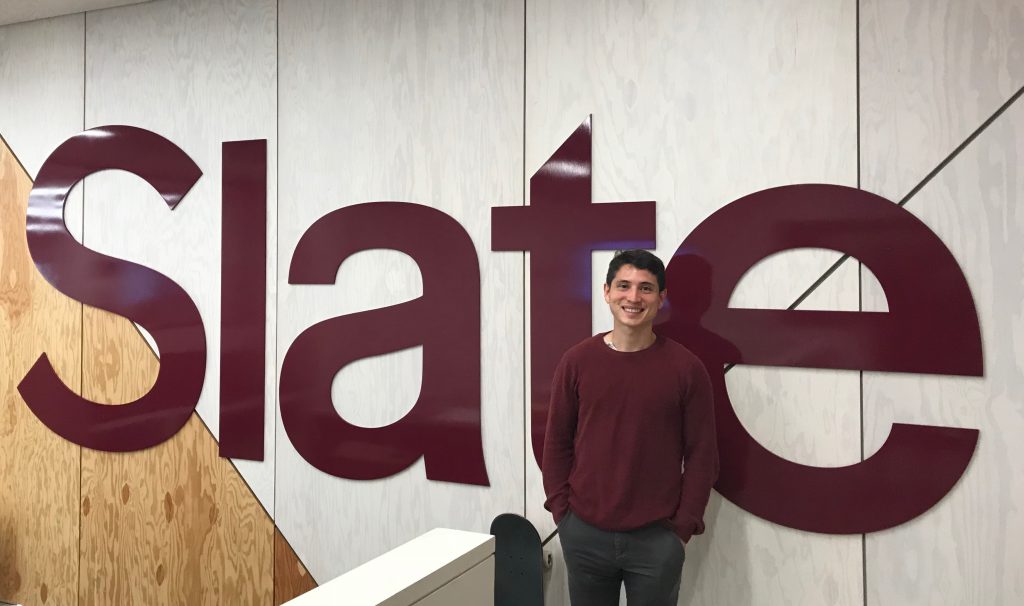
Irineo Cabreros, a fourth-year PhD student in applied mathematics at Princeton, spent his summer as a AAAS Mass Media Fellow working at Slate magazine.
This summer, I had the opportunity to write for the science desk at Slate magazine as a AAAS Mass Media Fellow sponsored by the ASA. While at Slate, I was surrounded by a community of passionate, amazing journalists. Slate is a special place with a special spirit about it. The employees pride themselves on the ability to offer fresh, unorthodox angles to any story, big or small. It’s a place for skeptics, contrarians, and obsessives. In many ways, Slate people are my kind of people.
Irineo Cabreros is a fourth-year PhD student in applied mathematics at Princeton, where he studies statistical genomics. His primary interests are in population genetics (understanding human genetic diversity), causal inference (disentangling correlation from causation), and the interplay between the two (harnessing genetic diversity to understand gene function).
But in other ways, I was a fish out of water. I was used to the slow, plodding nature of academia. By contrast, Slate moved a blistering pace. Sometimes, 24 hours marked the entire life of a piece—from idea to publication. As a journalist, I was forced to ask myself questions about science that I rarely thought about in lab. Will a typical reader understand what I’m saying? This sentence isn’t quite air tight, but is a gain in precision worth the potential loss of understanding? And really, will anyone really care about this? If not, should they? If so, how can I convince them it matters? I had a lot to learn when I arrived at Slate. I was pushed out of my comfort zone and challenged tremendously. But as a result, I grew a lot.
In journalism, a little knowledge of statistics can go a long way—statistics is slippery, subtle, and omnipresent. Several of my favorite pieces this summer were those that drew on my expertise in statistics. I wrote a critique of a much-hyped study some believed implied the possibility of immortality. But as basic probability makes clear, I argued the unfortunate and sober truth that you are definitely going to die. In the heat of summer, with record temperatures being recorded all over the globe, I reported on the statistics of attribution: Can we really blame the summer heat on global warming? And considering the high-profile Harvard discrimination lawsuit, I talked about the difficulty of statistical evidence in legal testimony.
One of the most valuable aspects of this work was that, in writing about statistics, I became introspective about my own academic research. In trying to understand the effect of statistics to an average person, I was forced to think about the impact my work might have on people outside academia. It is easy to have tunnel vision in graduate school; this summer forced me to zoom out.
Working as a journalist also gave me the incredible luxury of diving deep into some of my everyday curiosities. As a Muslim, I had always wondered about the health effects of Ramadan fasting and was able to talk to leaders in the field of longevity research who patiently answered my questions. I also got to talk to butchers and bankers about logistics and the effect of Islamic philanthropy. As a soccer enthusiast, I got to think about penalty kick strategy. And as a health nut, I got to dive into the murky world of omega-3 supplements.
My experience this summer hooked me. I left Slate flush with inspiration for future projects and hungry to keep going. I began the summer as a dabbler in science communication. Now, I don’t think I can imagine a future without journalism being part of it.
If you are a graduate student or recent PhD in any STEM-related field who is interested in science journalism, I would highly suggest you apply for the AAAS Mass Media Fellowship. You don’t need to have extensive journalism experience on your résumé, but rather a few examples of nontechnical science writing and a passion for science communication. Application details are available on the AAAS webpage.
If you are completely green (as I was a little more than a year ago), a good place to start getting experience is the Massive Science Consortium. There, you will find mentorship, community, and a platform for quickly getting your pieces on the internet.
Whether you are interested in becoming a full-fledged science writer or you are a scientist who just wants to become a better communicator, the AAAS Mass Media Fellowship is right for you. It’s an incredible, eye-opening, and life-changing experience.
Follow Irineo Cabreros on Twitter: @cabrerosic




Leave a Reply